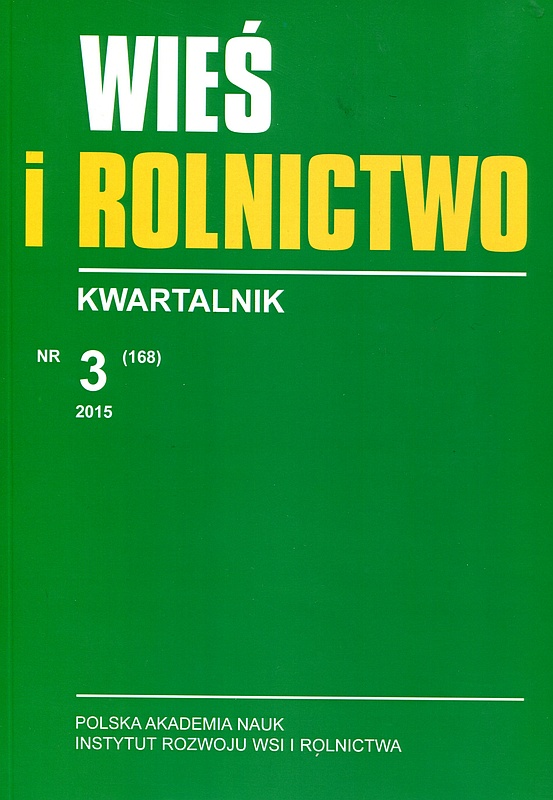The social capital of Pomeranian rural areas: on the measuring, balance and perspectives of development
DOI:
https://doi.org/10.53098/wir.2015.3.168/02Keywords:
kapitał społeczny, rozwój lokalny, aktywizacja społeczności lokalnych, wieś pomorskaAbstract
Abstract: This article presents an examination of results of a study, together with the original methodology used, on the level and balance of social capital in the rural areas of Pomerania, and how this can be related to the development potential of local communities. The results of studies in nineteen rural communities in Pomerania clearly indicated that levels of capital for development were not the main reason for poor development, but rather the a negative balance between various individual elements that, together, comprise social capital. Local inhabitants who were surveyed associate their ability to act with the lack of informal relationships with Public Sector and not locally based Non Governmental Organisations.The tendency observed has been for widespread appearance of ineffective and socially poorly viable communities, which, when there are initiatives and the availability of external development funds have little chance to implement projects or achieve results. Further it is the balance of social resources and poor institutional development which limits the potential for external involvement in the investigated communities. This drastically reduces the institutional capacity of communities and decreases the density of networks and relationships that links the community with managing its own development. The study showed that rural inhabitants in Pomerania do bestow trust in local self government, however relatively few participate in its work.Various variables were tested and of these research revealed a strong correlation between economic situation and balance of social capital of the respondent these, however did not correspond with predictions formed on the basis of a strong local identity and the dynamics of the community as a whole.References
Bednarek-Szczepańska M., 2013: Zróżnicowanie przestrzenne kapitału społecznego w Polsce – ujęcie przeglądowe. Przegląd Geograficzny t. 85, z. 4. DOI: https://doi.org/10.7163/PrzG.2013.4.4
Bartkowski J., 2007: Kapitał społeczny i jego oddziaływanie na rozwój w ujęciu socjologicznym. [w]: Kapitał ludzki i kapitał społeczny a rozwój regionalny, M. Herbst (red.). Wydawnictwo Naukowe Scholar, Warszawa.
Czapiński J., 2007: Kapitał społeczny. [w]: Diagnoza społeczna 2007, J. Czapiński, T. Panek (red.). Rada Monitoringu Społecznego, Warszawa.
Dudwick N., Kuehnast K., Nyhan-Jones V., Woolcock M., 2006: Analyzing Social Capital in Context: a Guide to Using Qualitative Methods and Data. World Bank Working Papers.
Działek J., 2011: Kapitał społeczny – ujęcia teoretyczne i praktyka badawcza. Studia Regionalne i Lokalne, tom 45.
Ellison N., Steinfeld Ch., Lampe C., 2007: The benefits of Facebook „Friends”. Social Capital and College Students’ Use of Online Social Networks Sites. Journal of Computer – Mediated Communications, vol. 12, issue 4. DOI: https://doi.org/10.1111/j.1083-6101.2007.00367.x
Fedyszak-Radziejowska B., 2005: Wiarygodność metod jakościowych i sondaży w badaniach kapitału społecznego wsi. [w:] Wielozawodowość na obszarach wiejskich, K. Gorlach, G. Foryś (red.). Wydawnictwo Uniwersytetu Jagiellońskiego, Kraków.
Field J., 2008: Social Capital. Routledge, London. DOI: https://doi.org/10.4324/9780203930519
Fine B., 2010: Theories of Social Capital: Researchers Behaving Badly. Pluto Press, London.
Fox J., 1996: How does civil society thicken? The political construction of social capital in rural Mexico. World Development, vol. 24. DOI: https://doi.org/10.1016/0305-750X(96)00025-3
Frykowski M., Starosta P., 2005: Kapitał społeczny na terenie województwa łódzkiego. [w:] Wielozawodowość na obszarach wiejskich, K. Gorlach, G. Foryś (red.). Wydawnictwo Uniwersytetu Jagiellońskiego, Kraków.
Furmankiewicz M., Janc K., 2011: Wpływ Programu Pilotażowego LEADER+ na aktywność gmin należących do partnerstw terytorialnych. Wieś i Rolnictwo, nr 1/2011. DOI: https://doi.org/10.53098/wir.2011.1.150/05
Furmankiewicz M., Stefańska J., 2010: Partnerstwo terytorialne jako sieci organizacyjne. Analiza powiązań w trzech wybranych lokalnych grupach działania w Polsce. Studia Regionalne i Lokalne, tom 89.
Grootaert Ch., Narayan D., Nyhan-Jones V., Woolcock M., 2004: Measuring Social Capital: an Integrated Questionnaire. World Bank Working Paper no. 18. DOI: https://doi.org/10.1596/0-8213-5661-5
Halamska M., 2008: Kapitał społeczny wsi: próba rekonstrukcji. Przegląd Socjologiczny, Tom LVII.
Hauberer J., 2011: Social Capital Theory: towards a methodological foundation, VS Research Springer fachmedien. Wiesbaden.
Healy T., 2001: The measurement of social capital at international level. OECD Papers.
Herbst J., 2008: Inny trzeci sektor. Organizacje pozarządowe na terenach wiejskich. [w:] Wiejskie organizacje pozarządowe, M. Halamska (red.). IRWiR PAN, Warszawa.
Janc K., 2009: Zróżnicowanie przestrzenne kapitału ludzkiego i społecznego w Polsce. Rozprawy Naukowe Instytutu Geografii i Rozwoju Regionalnego, Wydawnictwo Uniwersytetu Wrocławskiego, Wrocław.
Knieć W., Goszczyński W., Obracht-Prondzyński C., 2013: Kapitał społeczny wsi pomorskiej. Kaszubski Uniwersytet Ludowy, Wieżyca.
Portes A., 1998: Social capital: Its origins and applications in modern sociology. Annual Reviews of Sociology, vol. 24. DOI: https://doi.org/10.1146/annurev.soc.24.1.1
Psyk-Piotrowska E. (red.), 2009: Kapitał społeczny, partycypacja obywatelska, rozwój lokalny. Wydawnictwo Uniwersytetu Łódzkiego, Łódź.
Putnam R., 2000: Bowling Alone: the collapse and revival of American community. Simon & Schuster, New York. DOI: https://doi.org/10.1145/358916.361990
Putnam R., 1995: Bowling Alone: America’s Declining Social Capital. Journal of Democracy, vol. 1 (6). DOI: https://doi.org/10.1353/jod.1995.0002
Seręga Z., 2006: Nieufni klienci demokracji. Atrofia kapitału społecznego wspólnot lokalnych w Polsce dzisiejszej doby. [w:] Jednostkowe i społeczne zasoby wsi, K. Szafraniec (red.). IRWiR PAN, Warszawa
Storberg J., 2002: The evolution of capital theory; a critique of a theory of social capital and implications for human resources development. Human Resource Development Review, vol. 1. DOI: https://doi.org/10.1177/1534484302238437
Trutkowski C., Mendes S., 2005: Kapitał społeczny w małych miastach. Wydawnictwo Naukowe Scholar, Warszawa.
Van Oorschot W., Arts W., Gelissen J., 2006: Social capital in Europe. Acta Sociologica. DOI: https://doi.org/10.1177/0001699306064770
Wiktorzak A., 2009: Kapitał społeczny szkoły. [w:] Badania zagraniczne i wzory międzynarodowe w diagnostyce edukacyjnej, B. Niemierko, M. Szmigel (red.). OPRDE, Kraków.
Woolcock M., 1998: Social capital and economic development: toward a theoretical synthesis and policy framework. Theory and Society, vol. 27.
Zajda K., 2011: Czym jest kapitał społeczny mieszkańców polskiej wsi, jak go mierzyć i czy warto inwestować w jego wzmacnianie. Acta Universitas Lodziensis, tom 37.
Zajda K., Kretek-Kamińska A., 2014: Wykorzystanie zasobów lokalnych grup działania. Wydawnictwo Uniwersytetu Łódzkiego, Łódź.
Downloads
Article file downloads
Pages
How to Cite
Issue
Section
License
Copyright (c) 2015 Wieś i Rolnictwo

This work is licensed under a Creative Commons Attribution 4.0 International License.










